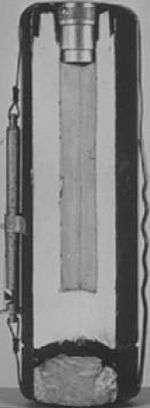M125 bomblet

The M125 bomblet was a U.S. chemical sub-munition designed to deliver the nerve agent sarin. It was brought into service in 1954 with the M34 cluster bomb as part of the first U.S. air-delivered nerve agent weapon.
History
The M125 bomblet was a sub-munition of the M34 cluster bomb, which was first brought into regular service by the United States Army in 1954.[1] In development the M125 was known as the E54R6 bomblet (shortened to E54).[2] The M34 and its payload of M125s was the first air-delivered nerve agent weapon in the U.S. chemical arsenal.[2] Later, the Chemical Corps developed chemical-biological warheads for multiple missile systems including, Matador, Rascal, Snark, and Navaho missiles.[2] These warheads incorporated the M125 bomblet and the M114 bomblet.[2] Over 21,000 of the M125 containing M34 bombs were destroyed at Rocky Mountain Arsenal in 1976.[3]
Specifications
The M34 was designed to hold 76 M125 bomblets,[1] arranged in four groups of 19.[3] Each bomblet held 2.6 pounds of the nerve agent sarin, and 8.8 ounces of the explosive tetryl.[3] The ten pound cylindrical M125 bomblet also held an opening delay, fuze and parachute, as well as a burster, which contained the explosive.[3] A M34 cluster bomb, fully loaded with M125 bomblets, had an agent weight to weapon weight ratio of 17 percent; the M34 and M125 were not the best delivery system.[2] Eventually, cylindrical chemical bomblets, such as the M125, were supplanted by spherical models because they could obtain a greater coverage area.[2]
References
- 1 2 Smart, Jeffery K. Medical Aspects of Chemical and Biological Warfare: Chapter 2 — History of Chemical and Biological Warfare: An American Perspective, (PDF: pp. 41-42), Borden Institute, Textbooks of Military Medicine, PDF via Maxwell-Gunter Air Force Base, accessed December 28, 2008.
- 1 2 3 4 5 6 Kirby, Reid. "The CB Battlefield Legacy: Understanding the Potential Problem of Clustered CB Weapons", Army Chemical Review, July–December 2006, accessed December 28, 2008.
- 1 2 3 4 Mauroni, Albert J. Chemical Demilitarization: Public Policy Aspects, (Google Books), Greenwood Publishing Group, 2003, p. 19, (ISBN 027597796X).